
The Sydney Morning Herald (SMH) is a daily tabloid newspaper published in Sydney, Australia, and owned by Nine Entertainment. Founded in 1831 as the Sydney Herald, the Herald is the oldest continuously published newspaper in Australia and claims to be the most widely read masthead in the country. The newspaper is published in compact print form from Monday to Saturday as The Sydney Morning Herald and on Sunday as its sister newspaper, The Sun-Herald and digitally as an online site and app, seven days a week. It is considered a newspaper of record for Australia. The print edition of The Sydney Morning Herald is available for purchase from many retail outlets throughout the Sydney metropolitan area, most parts of regional New South Wales, the Australian Capital Territory and South East Queensland.

Digger is a military slang term for primarily infantry soldiers from Australia and New Zealand. Evidence of its use has been found in those countries as early as the 1850s, but its current usage in a military context did not become prominent until World War I, when Australian and New Zealand troops began using it on the Western Front around 1916–17. Evolving out of its usage during the war, the term has been linked to the concept of the Anzac legend, but within a wider social context, it is linked to the concept of "egalitarian mateship".

The Wipers Times was a trench magazine that was published by British soldiers fighting in the Ypres Salient during the First World War.

Louisa Lawson was an Australian poet, writer, publisher, suffragist, and feminist. She was the mother of the poet and author Henry Lawson.

William Henry ('Will') Dyson was an Australian illustrator, artist and political cartoonist who achieved international recognition. He initially worked as a freelance artist in Australia, developing a specialty as a caricaturist, notably in The Bulletin magazine. In 1909 Dyson married Ruby Lindsay and the couple settled in London soon afterwards. As cartoonist for The Daily Herald newspaper, Dyson became widely known as an illustrator and commentator supporting progressive social reforms in Britain. His cartoons were often controversial, tackling difficult issues such as poverty, inequality and war, and were characterised by their biting wit and artistic impact. At the outbreak of World War I Dyson directed his scathing artwork at German militarism. In 1916 he applied to join the Australian forces at the Western Front as an artist. He was appointed an honorary lieutenant and joined the Anzac troops in France in January 1917. By the following May his appointment as Australia's first official war artist was formalised. After the death of his wife in March 1919 Dyson went through a difficult emotional period, during which his artistic output suffered. In late 1924 he returned to Australia after accepting a contract to work for the Herald publishing group in Melbourne. Dyson returned to England in 1930. He died in London in 1938, aged 57.
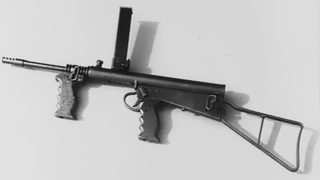
The Owen gun, known officially as the Owen machine carbine, was an Australian submachine gun that was designed by Evelyn Owen in 1938. The Owen was the only entirely Australian-designed and constructed service submachine gun of World War II. It was used by the Australian Army from 1942 until 1971.

Stanley George Cross was born in the United States but was known as an Australian strip and political cartoonist who drew for Smith's Weekly and the Herald & Weekly Times. Cross is famous for his iconic 1933 "For gorsake, stop laughing: this is serious!” cartoon as well as the Wally and the Major and The Potts cartoon strips.
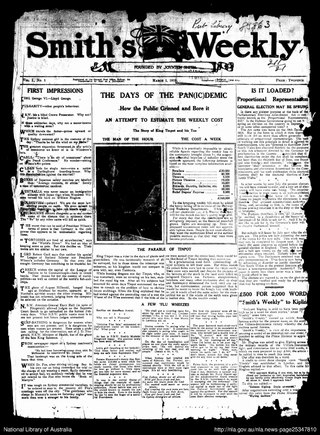
Smith's Weekly was an Australian tabloid newspaper published from 1919 to 1950. It was an independent weekly published in Sydney, but read all over Australia.

The Australasian Post, commonly called the Aussie Post, was Australia's longest-running weekly picture magazine.
Chance International was a men's magazine founded in Sydney in 1966 by Gareth Powell Associates, which was basically Gareth Powell in association with Jack de Lissa. It used Playboy and Penthouse magazines as a model, creating a magazine that Australia had not seen before with both pictures of beautiful unclothed ladies and articles worth reading. The magazine was originally printed in Australia with the Griffin Press in Adelaide but almost immediately switched to Hong Kong as high quality printing at an affordable price was not then available in Australia.
Bluey and Curley is an Australian newspaper comic strip written by the Australian artist, caricaturist, and cartoonist Alex Gurney.

Douglas Grant was an Aboriginal Australian soldier, draughtsman, public servant, journalist, public speaker, and factory worker. During World War I, he was captured by the German army and held as a prisoner of war at Wittenberg, and later at Wünsdorf, Zossen, near Berlin.

Sainik Samachar is a journal about the India's Armed Forces. The journal is published every fortnight in thirteen languages including English on behalf of the Ministry of Defence, Government of India.
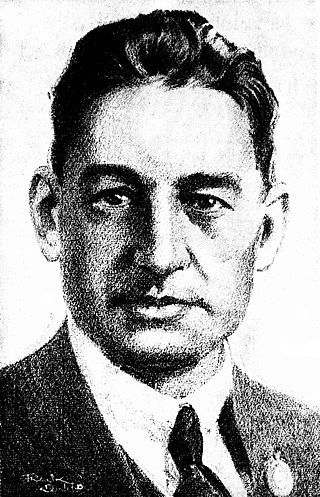
Cecil Lawrence Hartt was an Australian cartoonist and caricaturist. As a wartime artist, he popularised the concept of the Australian digger as independent, easy-going and disrespectful of authority, with a sardonic attitude to life. He was the first artist to be employed by Smith's Weekly in 1919, continuing in that role until his death in 1930. Over his career Hartt produced a large number of cartoons on a broad range of subjects and themes; his drawings encompassed political, social and military topics and were admired for their observational humour and the quality of his character portraits. He mainly drew single-panel cartoons, but his body of work also includes early examples of Australian comic strips. Hartt was the first president of the Australian Black and White Artists' Club, formed in July 1924.
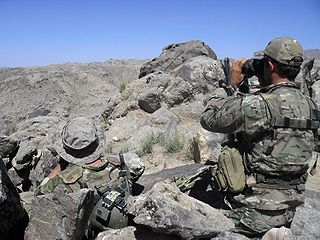
The Shah Wali Kot Offensive was a five-day joint operation during the War in Afghanistan, conducted by Australian special forces and the Afghan National Army with US air support, between 10 and 14 June 2010. The operation took place in the Shah Wali Kot District of Kandahar Province, occurring in preparation for the coalition clearance of the province and resulting in heavy insurgent casualties.

Australian comedy refers to the comedy and humour performed in or about Australia or by the people of Australia. Australian humour can be traced to various origins, and today is manifested in a diversity of cultural practices and pursuits. Writers like Henry Lawson and Banjo Paterson helped to establish a tradition of laconic, ironic and irreverent wit in Australian literature, while Australian politicians and cultural stereotypes have each proved rich sources of comedy for artists from poet C. J. Dennis to satirist Barry Humphries to iconic film maker Paul Hogan, each of whom have given wide circulation to Australian slang.

Claude Arthur Marquet (1869–1920) was an influential Australian political cartoonist, noted for his bold illustrative style and strong commitment to the labour movement and radical politics.
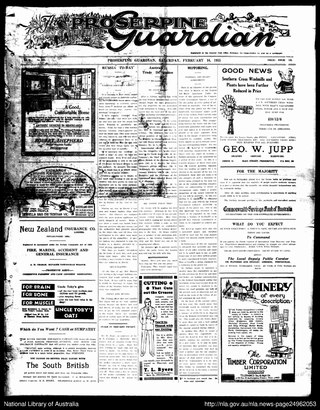
The Whitsunday Coast Guardian is a newspaper published in Proserpine, Whitsunday Region, Queensland, Australia.
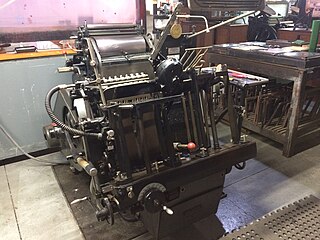
The Original Heidelberg Platen Press was a letterpress printing press manufactured by the Heidelberger Druckmaschinen company in Germany. It was often referred to as the Heidelberg Windmill, after the shape and movement of its paper feed system. When introduced, it was also called the "Super Heidelberg" or the "Super Speed".

A trench magazine describes a type of publication made by and for soldiers during the First World War while living in the trenches. These magazines appear solely within the time frame of World War I (1914-1918), and within Europe, with most being British, French, or German. There were also some minor American, Canadian, and Australian magazines in this genre that existed as well.


















